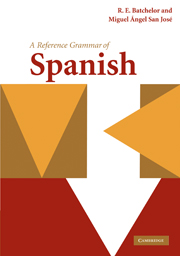Book contents
- Frontmatter
- Contents
- Preface/Prólogo
- Acknowledgments/Agradecimientos
- Abbreviations/Abreviaturas
- Introduction to the Spanish language/Introducción a la lengua española
- Part I
- Part II
- Part III
- Part IV
- 55 Subjunctive mood/Modo subjuntivo
- Part V
- Part VI
- Part VII
- Part VIII
- Part IX
- Part X
- Appendix I Verb tables/ Tablas de verbos
- Appendix II Glossary/Glosario
- Bibliography/Bibliografía
- General index/Índice general
- Subjunctive index/Índice del subjuntivo
55 - Subjunctive mood/Modo subjuntivo
from Part IV
Published online by Cambridge University Press: 05 June 2012
- Frontmatter
- Contents
- Preface/Prólogo
- Acknowledgments/Agradecimientos
- Abbreviations/Abreviaturas
- Introduction to the Spanish language/Introducción a la lengua española
- Part I
- Part II
- Part III
- Part IV
- 55 Subjunctive mood/Modo subjuntivo
- Part V
- Part VI
- Part VII
- Part VIII
- Part IX
- Part X
- Appendix I Verb tables/ Tablas de verbos
- Appendix II Glossary/Glosario
- Bibliography/Bibliografía
- General index/Índice general
- Subjunctive index/Índice del subjuntivo
Summary
Below is a humorous piece of Spanish illustrating the use of the present subjunctive. The author foresees his own burial and encourages his friends not to mourn him.
Cuando regresemos de mi propio entierro quiero que entremos en el bar de la esquina, donde tantas veces hemos cantado, para que nos pongan unos vinos y cantemos unas canciones en mi recuerdo. Yo os digo ahora que no estéis tristes, que otros lloren si lo desean, porque deseo que seáis felices, tanto cuanto yo lo sea.
Luego, cuando volváis a casa, tras haber rezado por mí, os concedo permiso para que podáis contar anécdotas y os riáis de mis tonterías, que, quizá, sean muchas, porque yo, seguramente, ría con vosotros desde la otra orilla.
Forms of the subjunctive
The subjunctive may have all but disappeared in English, although we still use it on occasions (If I were you), and it is slowly slipping away in French, where, of the imperfect subjunctive, for example, only the third person singular (parlât, rendît) is used, and even here sparingly. However, it is still very much a mood to be reckoned with in Spanish, in both Spain and Spanish America. So it is a very necessary tool for correct expression in Spanish. This is very similar to the case with Italian, in fact. Before embarking on the subjunctive in Spanish, it is instructive to see how complicated it is to express the subjunctive in English.
- Type
- Chapter
- Information
- A Reference Grammar of Spanish , pp. 279 - 298Publisher: Cambridge University PressPrint publication year: 2010



